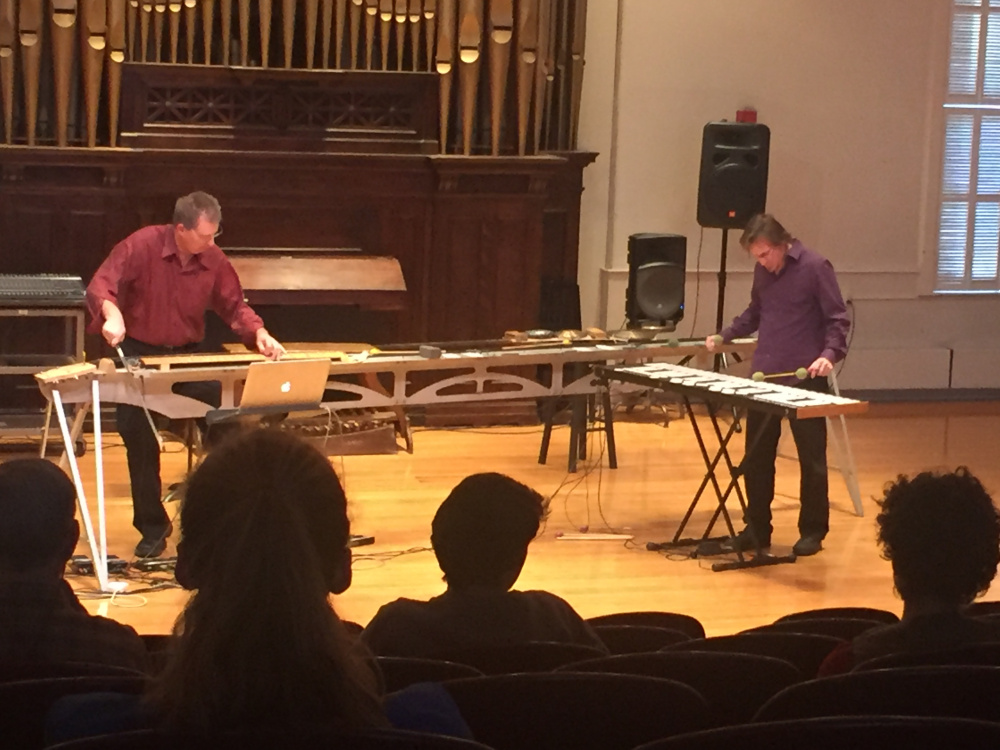Like any savvy music theater producer, the University of Southern Maine is keeping “Molded by the Flow,” the new work that its music, theater and art students are developing, largely under wraps – yet visible enough to keep you curious. The piece, which will be staged in April in Lewiston and Gorham, is a meditation on the ways nature has influenced the landscape and the history of Maine, but the details are anyone’s guess.
What listeners do know is that the students will have the advice of two supremely inventive visiting artists – Rinde Eckert, a composer, singer and multi-instrumentalist based in New York, and Paul Dresher, a composer, guitarist and drummer based in San Francisco. Neither is contributing material to the new work – that is the province of the students – but their styles and approaches are bound to be influential. Eckert showed something of what he does at a concert in September. On Sunday, it was Dresher’s turn.
The prolific Dresher does many different sorts of things, actually. This time he performed as part of the Paul Dresher and Joel Davel Invented Instrument Duo, using instruments they designed and built themselves.
Dresher’s instrument, the quadrachord, looks like a long, thin table, with a guitar fretboard at one end, four strings that run the instrument’s full length (160 inches), bass guitar pickups at either end, and an array of effects pedals. Dresher played it with a cello bow, his hands and mallets (the kind used by percussionists). At times, he played on the flat fretboard as if it were a piano keyboard.
Davel played two instruments. The marimba lumina, which he designed with synthesizer pioneer Don Buchla and percussionist Mark Goldstein, looks like an electronic marimba (the keys are visible on its flat surface, but are not separate wooden bars, as on an acoustic marimba) and is played with mallets. Each key can be programmed with a variety of timbres, attacks, releases and effects, so that if you slide the mallets along or across the keys, you can get sounds that no marimba could produce.
Davel’s second instrument, the Buchla lightning, a Buchla instrument on which Davel assisted, is a pair of wands that control and alter recorded sounds and programmed timbres (pedals and a laptop, which trigger these sounds, are part of the setup as well) as the player moves them through the performance space.
The three works Dresher and Davel played were semi-improvisational – that is, their structures and basic ideas were mapped out, but details within each section were governed by the players’ on-the-spot impulses. Dresher’s quadrachord and marimba lumina duets, “In the Name(less)” (2002-4) and “Glimpsed from Afar” (2006), brought to mind the expansive, early electronic tableaux of the German synthesizer band Tangerine Dream, as well as the bowed-guitar explorations that Jimmy Page used to produce with Led Zeppelin.
“In the Name(less),” which opened the program, used those bowing effects and percussion loops to create a spacey backdrop upon which gently tactile percussion timbres, sliding sounds that evoked whale song (albeit at a higher pitch) and alternately twangy and chunky bass figures were overlaid and expanded upon. The novelty of the instruments, not to mention Dresher’s and Davel’s imaginative use of them, gave the proceedings an exciting sense of mystery and surprise.
“Glimpsed from Afar” proceeded similarly, but with a significantly different timbral complexion, this time with percussion in the foreground, and with Davel contributing some appealing melodies on the marimba lumina. Eventually, Davel abandoned his own instrument and joined Dresher on the quadrachord (now fitted out with a tray of cymbals) in an energetic percussion duet, wreathed in variegated, metallic tones of the sort that drive John Cage’s “Third Construction.”
Between Dresher’s works, Davel played his “Out of Thin Air” (2014) on the Buchla lightning. The piece was amusingly choreographed – movement being central to the manipulation of the sounds – with its manipulated source materials ranging from straightforward voices to excerpts from Van McCoy’s 1975 hit, “The Hustle.”
It’s hard to know what hints (if any) the performance gave us about “Molded by the Flow.” But perhaps the students will take a page from Dresher’s playbook and build instruments of their own.
Allan Kozinn is a former music critic and culture writer for The New York Times who lives in Portland. He can be contacted at:
allankozinn@gmail.com
Twitter: kozinn
Copy the Story LinkSend questions/comments to the editors.



Success. Please wait for the page to reload. If the page does not reload within 5 seconds, please refresh the page.
Enter your email and password to access comments.
Hi, to comment on stories you must . This profile is in addition to your subscription and website login.
Already have a commenting profile? .
Invalid username/password.
Please check your email to confirm and complete your registration.
Only subscribers are eligible to post comments. Please subscribe or login first for digital access. Here’s why.
Use the form below to reset your password. When you've submitted your account email, we will send an email with a reset code.